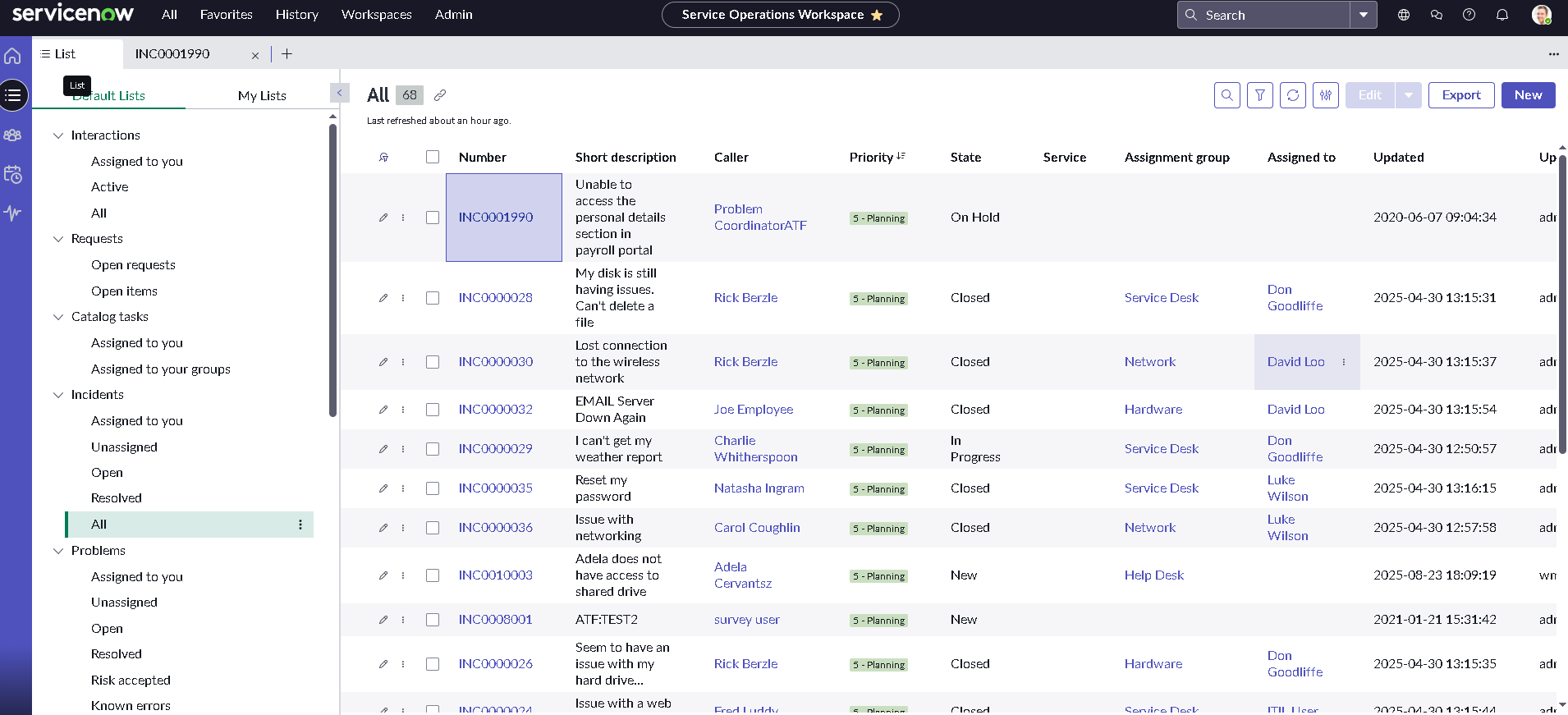ServiceNow ITSM Lab:
Working Tickets
I set up a Personal Developer Instance with ITSM enabled and used demo data to practice realistic ticket handling. My goal: become fluent in addressing, updating, escalating, and closing tickets while leveraging the Knowledge Base (KB).
Addressing New Tickets (Intake & Triage)
- Open Incident → Create New or pick from the unassigned queue.
- Capture core fields:
Caller,Short description,Description, evidence (attachments),Category/Subcategory, andService/CI. - Set Impact and Urgency to establish Priority consistently.
- Assign to the correct
Assignment groupandAssigned to(or claim it); add stakeholders toWatch list. - Use a template for frequent issues to prefill fields and reduce handle time.

Using Knowledge Base While Troubleshooting
I make KB search a default step during triage and diagnosis to drive First Contact Resolution and consistency.
- Search KB from the incident (related search or global): filter by product/service and keywords.
- Attach or link the relevant article to the incident so others see the path taken.
- If a workaround exists, apply it, note it in
Additional commentsfor the caller, and inWork notesfor internal context. - If no article fits, create one from the incident using the KCS-style template (Symptoms, Environment, Cause, Resolution, Validation) and submit to the correct knowledge base for review/publish.
- For repeat or widespread issues, propose/relate a Problem and attach the KB as the known error or workaround reference.

Communicating Clearly (Work Notes vs. Additional Comments)
- Work notes: internal-only updates for technicians (diagnostics, hypotheses, handoffs).
- Additional comments: customer-visible updates (acknowledgements, next steps, ETAs, workaround instructions).
- Use concise, timestamped updates so the ticket tells a complete story; @mention teammates if collaboration is needed.
- Notify the requester on key state changes and when input is required to avoid stalls.
Escalation When Needed
Functional Escalation
- Reassign to a specialized
Assignment group(e.g., Network, Messaging) when scope requires deeper expertise. - Include a brief handoff summary in
Work notesand keep the requester informed inAdditional comments.
Hierarchical Escalation
- Notify team leads/managers for blockers, high business impact, or risk of SLA breach.
- For widespread outages, initiate/relate to a Major Incident and link child incidents for communications at scale.
Relating Tickets for Context
- Child Incidents: link duplicates to a parent for centralized updates.
- Problem Records: create from incident when root-cause analysis is warranted; relate incidents and associated KB articles.
- Tasks: create follow-up tasks when work spans multiple teams but the incident remains the parent record of truth.
Resolving & Closing Tickets
- Document the Resolution information clearly: steps taken, root cause (if known), and validation performed.
- Select an appropriate Close code (e.g., solved permanently vs. workaround) and provide concise Close notes.
- Confirm with the requester (when policy requires) and move the ticket to Resolved; it auto-closes after the verification window, or close immediately if confirmation is received.
- If the issue returns, reopen with context and link to the prior ticket for continuity.
- When the fix is reusable, publish or update a KB article so the next engineer (or the customer portal) can solve it faster.
Working Request Tickets (RITMs)
- Approve or follow up on pending approvals; keep requesters informed about status and requirements.
- Complete fulfillment tasks in order; escalate to owning groups when outside access or specialized action is needed.
- Provide customer-facing updates in
Additional commentsand close the RITM once all tasks are completed and the requester confirms delivery.
What This Demonstrates
- Comfort operating the core ticketing flow: intake, triage, update, escalate, resolve, and close.
- Consistent use of Knowledge: search, apply, link, and publish articles to improve first-contact resolution.
- Professional communication: clear internal work notes and customer-facing updates that set expectations.
- Sound judgment on when to escalate and how to relate tickets (child, Problem, Major Incident) for visibility.